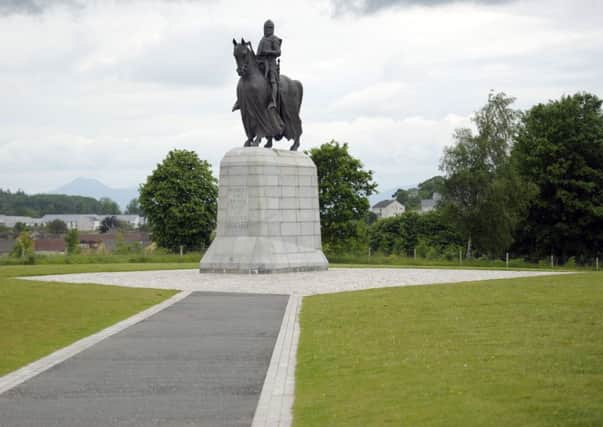Alistair Moffat: Bannockburn transcends


THE Battle of Bannockburn is one of the few events that genuinely changed the direction of Scotland’s history. Its outcome was far from inevitable; indeed it was a remarkably unlikely victory.
Defeat for King Robert and his famous captains might have seen a union of the crowns three centuries before James VI became James I. And instead of a Scots king riding south to rule, an English king may have come north to be crowned at Scone, or may have simply adopted the title without ceremony.
Advertisement
Hide AdAdvertisement
Hide AdThe consequences of that dynastic traffic could have been far-reaching in the shaping of modern Scotland. Wales had been brutally absorbed by Edward I and his successors as it became England’s first colony. If the English cavalry and their deadly archers had broken the ranks of Scottish schiltrons in 1314, Scotland may have become a second colony and, as in Wales, few of its distinctive institutions would have survived.
This year is more than the anniversary of a battle – remembered as it will be in great style with this weekend’s Bannockburn Live events involving hundreds of re-enactors in performances of the battle – it is also the year of Scotland.
With the Commonwealth Games in Glasgow and Ryder Cup at Gleneagles, images of Scotland and the joy and drama of sport will be broadcast around the world. In September, the eyes of the world will again be on this small nation as its people decide on its future. The question posed in the referendum offers a stark choice: do Scots wish to remain in the Union with England, Wales and Northern Ireland, or do they wish to live in an independent country?
Seven centuries ago, a very different sort of campaign on the issue of Scotland’s independence came to its climax at Bannockburn when, as one chronicler put it, “After the aforesaid victory Robert de Brus was commonly called King of Scotland by all men, because he had acquired Scotland by force of arms”.
For many reasons, 2014 seems an appropriate moment to remember how he did it. Like most Scots, until I began to read in some depth, I had no idea what a remarkable, stirring story it is. Physical evidence of the battle is lost. Since the late 19th century, debate has swirled around the precise site of the second, decisive day of the battle. Five different locations have been argued, with some of the more perceptive comments coming from retired soldiers, and a consensus now believes that the schiltrons marched in echelon on dry ground between the Pelstream Burn to the north-west and the Bannock Burn to the south-east. But no-one is sure.
Two difficulties cloud a clear picture of precisely where history was made on 24 June, 1314. The terrain is much changed from the days when Bruce and his captains rode around it, choosing their ground, planning how they might manoeuvre Edward II’s unwieldy, squabbling army into a position that would compress and weaken it.
They had to find a means of using the landscape to break up a force at least twice as large. But it is now difficult to see it how they saw it. Modern drainage schemes have converted the woodland, tussocky pasture and the wet and boggy carseland into flat, tidy and fertile fields.
While the gorge of the Bannock Burn remains an obstacle, the Pelstream Burn is much diminished, its banks now presenting no barrier. By the middle of the 18th century, the woods of the New Park had been cut down and much of its site has now disappeared under 19th- and 20th-century housing while roads criss-cross the area, the hum of the M9 only a few hundred yards from Bruce’s statue.
Advertisement
Hide AdAdvertisement
Hide AdBattlefields are silent places, the war-cries, trumpets, drums and screams of conflict long stilled, but archaeologists have sometimes found them eloquent. Even in acidic soil, metal arrowheads can be picked up, often on the surface, turned up by deep ploughing or discovered by the buzz of a metal detector. Many sheaves of arrows flew into the air above Bannockburn, but little or no trace of them has yet been found. Many men died as the schiltrons and heavy cavalry clashed but none of the mass graves described through the years have turned up. In 2001, a series of exploratory excavations by Tony Pollard and Neil Oliver failed to find any trace of pits, skeletal remains or any other evidence a great battle had been fought there. Finds were reported in the late 19th and early 20th centuries but were not properly recorded. And that is all.
It appears that Bannockburn has disappeared. Bruce’s epoch-making triumph has been lost, leaving a substantial gap in understanding and appreciating the tactical brilliance of King Robert and his commanders.
Unlike Flodden or Culloden, both still open farmland and moorland, Bannockburn has changed a great deal over seven centuries, as history has tramped again and again over the ground. But the memory of what happened on midsummer’s day 1314 is surely undimmed by gaps in knowledge. Enough is known to understand the tremendous significance of what took place. It was a battle that won a nation, a kingdom for a new king, the greatest warrior ever to wear the crown of Scotland. To stand at the foot of his statue and look up at Bruce’s stern gaze is to look at a man whose raw courage and intelligence helped shape Scotland. And to look around at the modern landscape, the housing and motorways is not to break a spell. To adapt a Gaelic phrase, at Bannockburn, it is still possible to hear the music of the thing as it happened.
• Bannockburn: Battle for a Nation by Alistair Moffat is published this month by Birlinn (www.birlinn.co.uk).